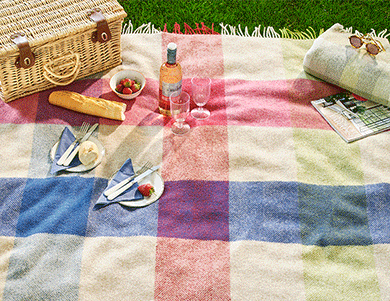Our Heritage
COMPANY HISTORY
As part of the MOON family, our rich heritage dates back all the way to the Victorian era. From producing and supplying quality fabrics to a growing Leeds market, to the global renown that has been built over the last 185 years - this rich tapestry of history is one of the many aspects that make our woollen accessories a credit to our commitment to quality and fine craft.
FROM HUMBLE BEGINNINGS TO INTERNATIONAL RENOWN
1837
A memorable year in at least 2 respects. It was the year in which Queen Victoria succeeded to the British throne and it was also the year in which Abraham Moon & Sons was founded.
Abraham Moon, a considerable standing in the community of Guiseley, on the Northern fringes of Leeds and the Southern fringes of the Yorkshire Dales, supplied many local families with yarn to weave cloth on hand looms in their homes. When the cloth was woven he would collect the pieces, paying the weavers for their work. The cloth was then scoured (washed) locally and hung out to dry in the surrounding fields. Abraham would then transport the pieces by horse and cart to Leeds for sale in the market.
1868
Following thirty years of tenacious Yorkshire grit and unabated entrepreneurship hardened by turbulent market conditions, Abraham Moon & Sons Ltd became officially incorporated as Abraham entered a business partnership with his two eldest sons
.
On the 25th of July 1868, Abraham’s youngest son – Arthur – laid the foundation stone for the original Netherfield Road woollen mill.
The mill itself had an abundant source of local spring water, which was ideal for certain necessary processes in woollen manufacturing, such as scouring. To this day, we still use this pure water spring; as manufacturing technology continually progresses, it is these historical details that make our fabrics unique.
MOON would enter the 1870s at the forefront of a thriving woollen market, championing their own signature Grey Tweed fabric.
1877
Come the Summer of 1877, the mills of the area were closed for the season’s holidays, and the town of Yeadon was preparing for its annual feast.
It was here that, sadly, Abraham Moon would unexpectedly pass in a carriage-related accident on the 20th of August 1877. A report from the local newspaper at the time sets the scene:
“Mr Moon was attending the annual Yeadon feast in his horse-drawn carriage. When a band struck up, the startled horse bolted down Henshaw Lane. Two passengers managed to jump clear and were unharmed, but Mr Moon stayed in his carriage trying to calm his horse. In its panic, it tried to turn into a familiar lane where there was no room for the carriage. The vehicle demolished part of a wall into which Abraham Moon was thrown. He died soon afterwards from a head injury”. It’s noted that the horse did survive the incident.
Following his passing, Abraham was buried on the 23rd of August, and his son Isaac succeeded him in the business.
1902
In an unprecedented turn of events, during the early hours of the 12th of April 1902, a blaze erupted and tore through the entirety of the mill – originating from a storage space of raw materials.
In its original design, Netherfield Road Mill was a multi-storey structure – synonymous with pre-19th century mills – with wooden floors and ceilings. This inadvertently facilitated the fire to completely decimate the building’s interior, leaving behind only the original stone foundations.
However, there was a significant silver lining to this disaster with work to restore the mill to meet the more modern architecture of the 20th century. Thus, Netherfield Road Mill was re-erected as a single-storey building, allowing greater production efficiency.
1920
The Moon family sold their shares in the company in order to pursue other interests. The shares were purchased by Charles H Walsh who was both designer and mill manager at the time with the borrowed sum of £33,000, the equivalent of £1.25m today. Charles' death in 1924 saw the company passed onto his son Frank, who was already in the business.
1954
Frank’s nephew Arthur took control, only retiring as chairman in 2010. The current managing director is John Walsh, the fourth generation of the family which succeeded the Moon dynasty. 1952 also marked a further extension of the mill, still located at the original site on Netherfield Road, making more room for the warping and weaving of the fabrics.
1990
Throughout the 1990's, wool faced increased competition from man-made fabric. While many mills tried (and failed) to compete on price, Moon focused on quality and concentrated on the luxury market, taking advantage of the manufacturing control and consistency that only a vertical mill can offer. Our customer list includes major international brands such as Burberry, Paul Smith, and Ralph Lauren.
2009
Bronte Tweeds was purchased by Abraham Moon & Sons. Already a well-known producer of throws and tartans, the combination of Bronte's extensive market knowledge and our dedicated in-house design team and manufacturing versatility has seen our accessories division grow exponentially in the years since.
Today, our accessories brand is known as “Bronte By Moon”, aptly named for our roots in Yorkshire through our historic woollen mill.

